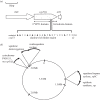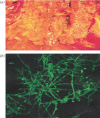Microbial cytochromes P450: biodiversity and biotechnology. Where do cytochromes P450 come from, what do they do and what can they do for us?
- PMID: 23297358
- PMCID: PMC3538425
- DOI: 10.1098/rstb.2012.0476
Microbial cytochromes P450: biodiversity and biotechnology. Where do cytochromes P450 come from, what do they do and what can they do for us?
Abstract
The first eukaryote genome revealed three yeast cytochromes P450 (CYPs), hence the subsequent realization that some microbial fungal genomes encode these proteins in 1 per cent or more of all genes (greater than 100) has been surprising. They are unique biocatalysts undertaking a wide array of stereo- and regio-specific reactions and so hold promise in many applications. Based on ancestral activities that included 14α-demethylation during sterol biosynthesis, it is now seen that CYPs are part of the genes and metabolism of most eukaryotes. In contrast, Archaea and Eubacteria often do not contain CYPs, while those that do are frequently interesting as producers of natural products undertaking their oxidative tailoring. Apart from roles in primary and secondary metabolism, microbial CYPs are actual/potential targets of drugs/agrochemicals and CYP51 in sterol biosynthesis is exhibiting evolution to resistance in the clinic and the field. Other CYP applications include the first industrial biotransformation for corticosteroid production in the 1950s, the diversion into penicillin synthesis in early mutations in fungal strain improvement and bioremediation using bacteria and fungi. The vast untapped resource of orphan CYPs in numerous genomes is being probed and new methods for discovering function and for discovering desired activities are being investigated.
Figures






References
-
- Wickramashighe RH, Villee CA. 1975. Early role during chemical evolution for cytochrome P450 in oxygen detoxification. Nature 256, 509–51010.1038/256509a0 (doi:10.1038/256509a0) - DOI - DOI - PubMed
-
- Rasmussen B, Fletcher IR, Brocks JJ, Kilburn MR. 2008. Reassessing the first appearance of eukaryotes and cyanobacteria. Nature 455, 1101–110410.1038/nature07381 (doi:10.1038/nature07381) - DOI - DOI - PubMed
-
- Waldbauer JR, Newman DK, Summons RF. 2011. Microaerobic steroid biosynthesis and the molecular fossil record of Archean Life. Proc. Natl Acad. Sci. USA 108, 13 409–13 41410.1073/pnas.1104160108 (doi:10.1073/pnas.1104160108) - DOI - DOI - PMC - PubMed
-
- Cavalier-Smith T. 2010. Deep phylogeny, ancestral groups and the four ages of life. Phil. Trans. R. Soc. B 365, 111–13210.1098/rstb.2009.0161 (doi:10.1098/rstb.2009.0161) - DOI - DOI - PMC - PubMed
-
- Love GD, et al. 2009. Fossil steroids record the appearance of Desmospongiae during the Cryogenian period. Nature 457, 718–72110.1038/nature07673 (doi:10.1038/nature07673) - DOI - DOI - PubMed
Publication types
MeSH terms
Substances
Grants and funding
LinkOut - more resources
Full Text Sources
Other Literature Sources
Molecular Biology Databases

